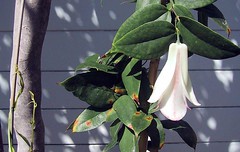"Exotic"
Here you can see the same Lapageria flower 12 days after it opened, without any signs of getting tired. I did notice stigmatic fluid (pardon my French) for the first time today; I wonder what it's been waiting for. You'll also notice two new shoots on the left that are now 2 feet tall without any sign of true (or at least adult) leaves. I'm starting to see why it's in Liliales. The... uh... brown spots date to some substandard gardening in early summer, which I can't blame on housesitters, unfortunately.
Hedychium update: In addition to the PBS discussion I found the other day, I did some actual research, with books:
Flowers July-September... Some growers have found [Hedychium coronarium] reluctant to flower, which may be due to the source of the plant material or the fact that the plants in question are not the true species. For other growers this ginger is among the earliest and most reliable flowerers in the genus. Plants thrive in full sun (although some leaf scorch may occur unless humidity levels are high), to bright shade, but flowering is most prolific when the plants are positioned to obtain at least some direct sun.
T. M. E. Branney, Hardy Gingers including Hedychium, Roscoea, and Zingiber (Timber Press, 2005).
I've already moved mine into morning sun. It may be too late.
This excellent book, by the way, reveals that many ginger species are hardy down to 5 degrees F. People think they're "exotic" because of how they look, but many are native to the high Himalayas. It was only in 1970 that someone finally noticed this at Kew, and planted out some H. densiflorum they'd been growing under glass for 100 years. So maybe you too can grow ginger.


0 Comments:
Post a Comment
<< Home